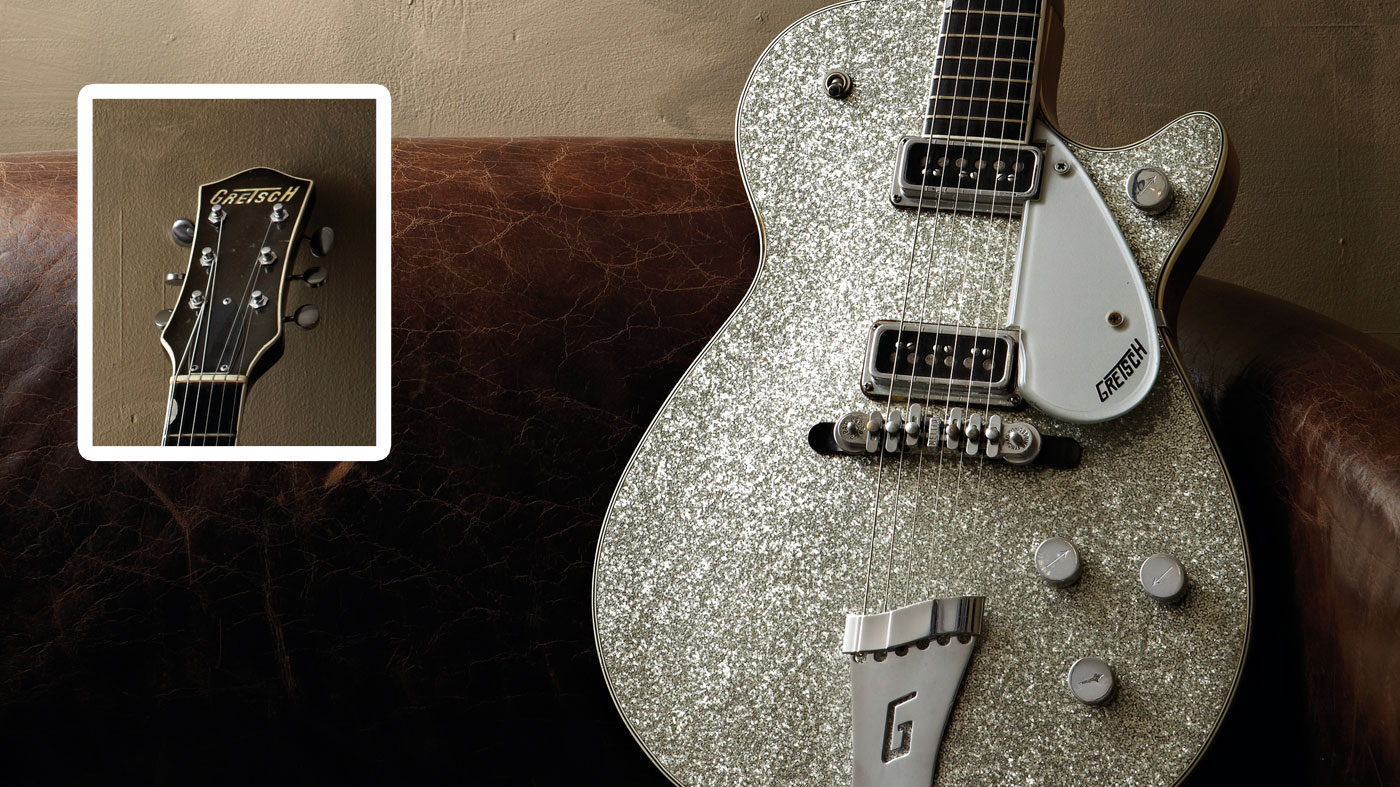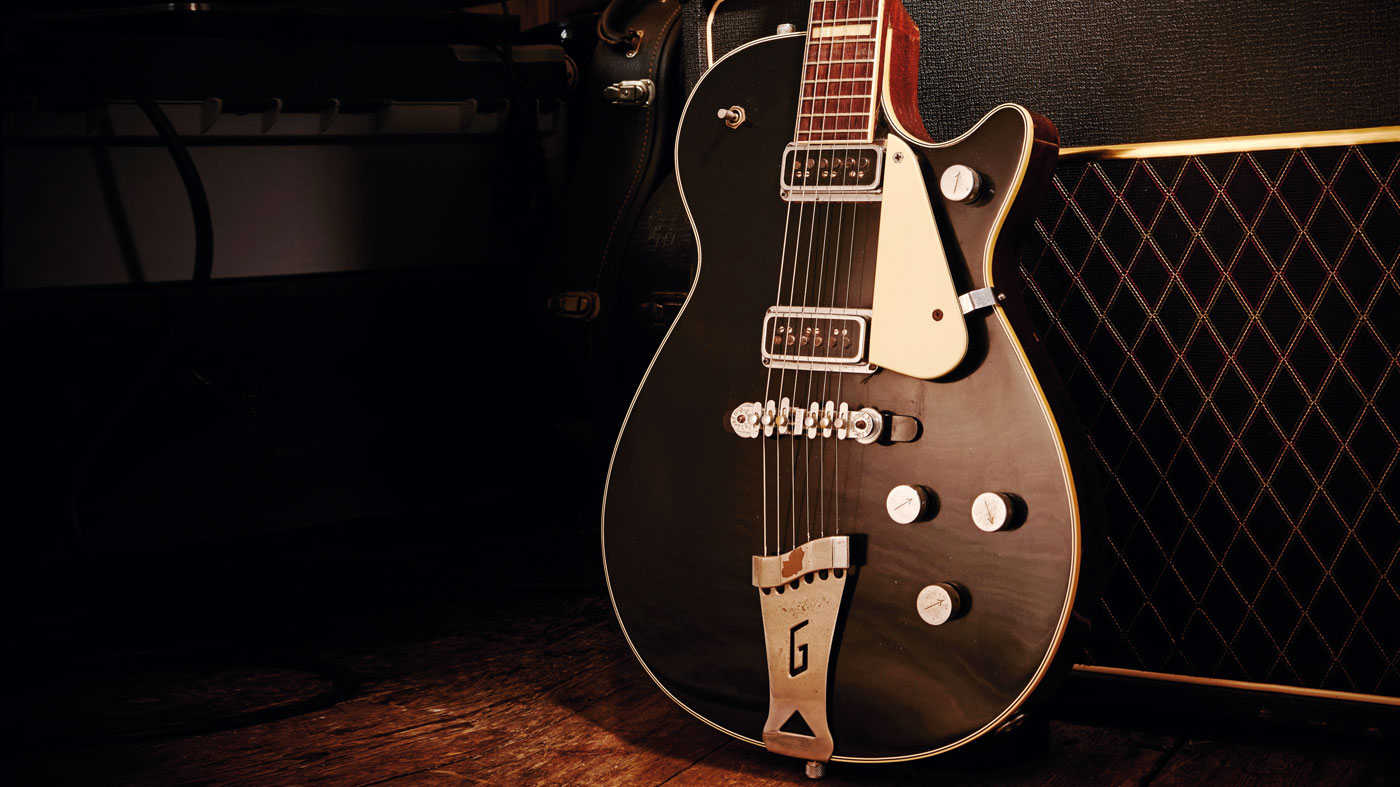Classic gear: Gretsch 6129 Silver Jet
Gretsch’s Duo-Jet gets a makeover in true 1950s silver sparkle sci-fi style...

The Gretsch 6129 Silver Jet was originally released in 1955 and has its origins in the design of the black top finish Gretsch 6128 Duo-Jet released in mid-1953 (later made famous by George Harrison). There are few distinguishing differences between the two guitars aside from finish, although they couldn’t be further apart in terms of modesty.
The silver sparkle finish is a Gretsch hallmark akin to the sparkle-finish drums they manufactured in the 1950s, and it just smacks of 50s sci-fi! According to anecdotal reports it was an employee of the factory that suggested Gretsch apply these eye-catching finishes to the Duo-Jet, and so the Silver Jet was born.
A chambered mahogany body with a pressed laminated maple arched top gave the guitar some unique acoustic characteristics
The early 50s were a revolutionary time for electric-guitar design and the new, futuristic electric solid-body guitar craze was well underway. In 1950, Fender had introduced their Broadcaster (later renamed the Telecaster) and, in response, 1952 saw Gibson release its version of a solid-body electric guitar in a striking gold finish: the Les Paul Model.
In many ways the Duo-Jet/Silver Jet could be likened to both the Fender Telecaster and Gibson Les Paul Model insofar as they are both seminal instruments of their type in terms of shape, but under the hood the Gretsch guitars were somewhat different.
As opposed to the Telecaster and Les Paul Model, they were not entirely solid and consisted of a chambered mahogany body with a pressed laminated maple arched top, which gave the guitar some unique acoustic characteristics.
DeArmond was one of the first companies to manufacture pickups having been in operation since the mid-1930s and was supplying Gretsch with a single-coil type as early as 1949, known at the time as the 200 model. This adjustable, high-output Alnico V pickup was later renamed the Dynasonic and the Silver Jet was released with two of them fitted as standard in both the bridge and neck position.

DeArmond Dynasonic pickups have a round, snappy, punchy and percussive tone and are often identified with the sound of Duane Eddy. Later, in 1958, the Silver Jet received a pair of fatter, crunchier sounding Filter’Tron humbucking pickups that were, much in the same way as Gibson’s humbuckers, intended to reduce the 60 cycle hum that plagued guitarists at the time.
Want all the hottest music and gear news, reviews, deals, features and more, direct to your inbox? Sign up here.
At this point, the layout of the Silver Jet’s controls altered slightly as the master tone knob relocated from the lower treble bout to the upper bass bout and was converted to a second switch adjacent to the pickup selector. Both independent pickup volume knobs remained on the lower treble bout, while the master volume knob was also retained on the upper treble bout.
Yet another major design feature change came in 1961 as the Silver Jet received a symmetrical double cutaway, which enabled players easier access to the upper frets, with a Burns vibrato arriving the following year.
In 1963, the 6129 Silver Jet was officially discontinued, although Gretsch continued to offer the same silver sparkle finish in the form of a Duo-Jet custom order.
1958 Gretsch 6129 Silver Jet

Serial number
5 digits typically in the 27000-30000 range inkstamped onto label located in control cavity
Headstock
‘T-roof’ Gretsch logo; single-bound peghead
Plastics
Grey plastic pickguard with black ‘T-roof’ Gretsch logo; white plastic heel overlay; black plastic truss rod cover
Hardware
Open backed metal tuners; chrome plated Melita Synchro-Sonic intonationadjustable bridge; chrome plated ‘G’ tailpiece; four metal ‘arrow’ knobs; 3-way pickup selector switch; chrome plated thumbscrew strap buttons
Pickups
Two high output DeArmond Dynasonic single coil Alnico V pickups with large adjustable pole pieces; independent pickup volume pots, master volume pot and master tone pot
Body
13¼-inches wide, 2-inches deep, single-cut chambered mahogany with pressed laminated maple arched top; triple (white/black/white) top binding; silver sparkle finish
Neck
24½-inch scale length, glued in mahogany neck with single-bound 12-inch radius ebony fretboard, ‘thumb print’ inlays and 22 narrow gauge nickelsilver frets
The Evolution of the Gretsch 6129 Silver Jet
- 1955 Two DeArmond Dynasonic pickups, block inlays and Melita Synchro-Sonic intonation-adjustable bridge
- 1956 Hump block inlays
- Early-1958 ‘Thumb print’ crescent shaped inlays over bass edge of fretboard up to 17th fret
- Mid-1958 Roller bridge added allowing space control between strings
- 1958 Two Gretsch Filter’Trons replace DeArmond Dynasonic pickups and master tone control changes
- 1959 Zero fret added
- 1961 Symmetrical double cutaway added for easier access to upper frets
- 1962 Burns vibrato and standby switch added; gold hardware and pickguard
- 1963 Discontinued as separate model (available as Duo-Jet custom finish order)
Rod Brakes is a music journalist with an expertise in guitars. Having spent many years at the coalface as a guitar dealer and tech, Rod's more recent work as a writer covering artists, industry pros and gear includes contributions for leading publications and websites such as Guitarist, Total Guitar, Guitar World, Guitar Player and MusicRadar in addition to specialist music books, blogs and social media. He is also a lifelong musician.


